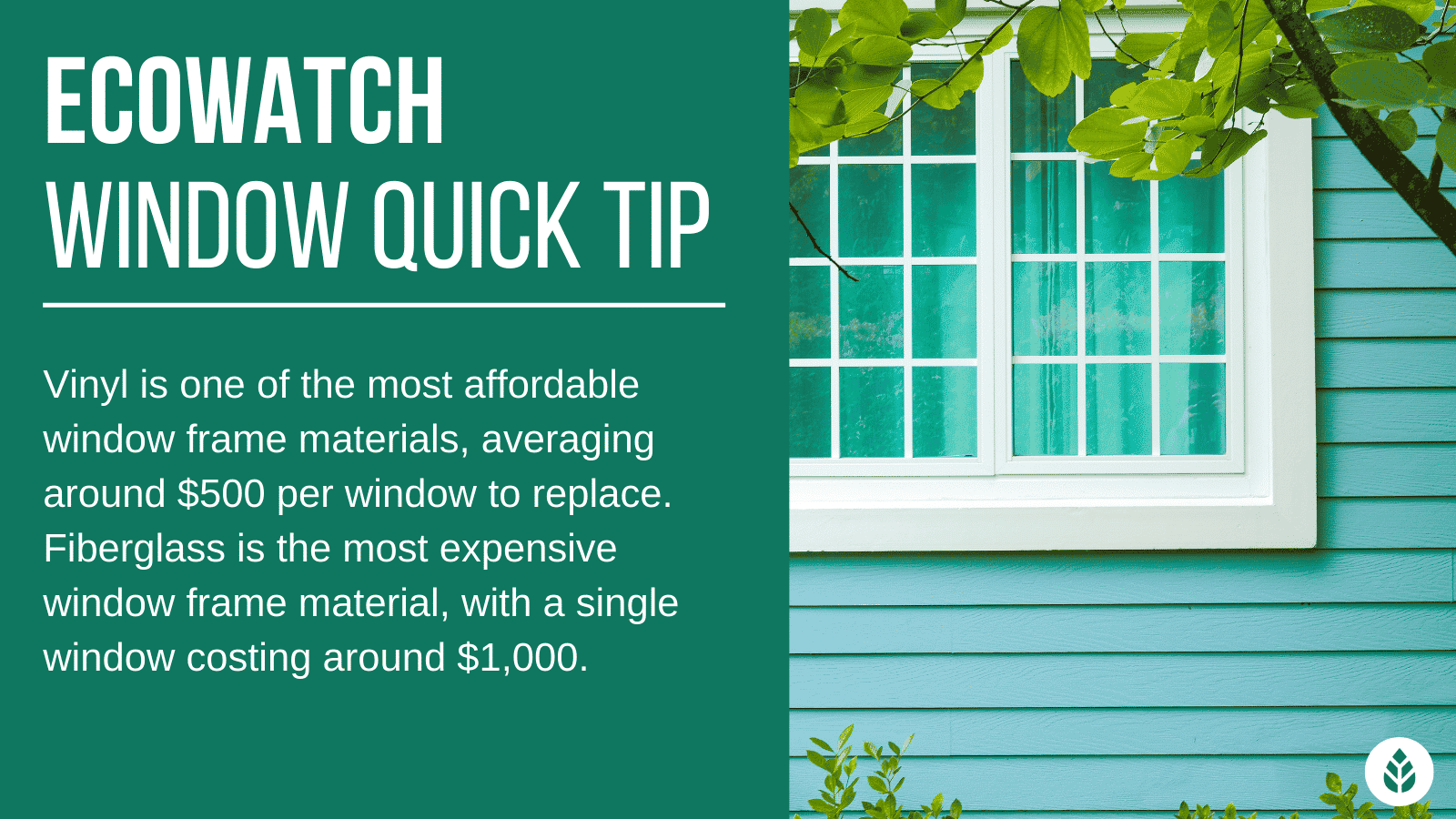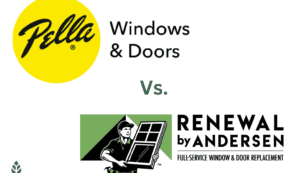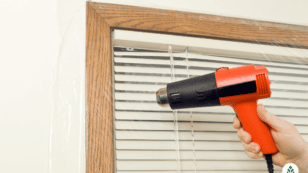

Fiberglass Vs. Vinyl Windows: Comparing Energy Efficiency, Affordability and More (2024)
In this guide of fiberglass and vinyl windows, you’ll learn:
- Are fiberglass or vinyl windows more efficient?
- What are the pros and cons of fiberglass windows?
- What are the pros and cons of vinyl windows?
- How does price, availability and maintenance compare for these windows?
If you are unsure whether to install fiberglass or vinyl windows in your home, this guide will ensure that you make the right decision by providing you with all the necessary information on each option. Enter your zip code below to receive a personalized quote on window option near you.
Each product and or company featured here has been independently selected by the writer. You can learn more about our review methodology here. If you make a purchase using the links included, we may earn commission.
If you’re considering window replacement and you’re not sure whether vinyl or fiberglass windows are a better choice for you, you’re in the right place.
When it comes time to replace your windows, you might feel a bit overwhelmed by the number of options you have for window frame material. Two of the most popular window options are fiberglass and vinyl, but most homeowners wonder which is better for their purposes, especially given the large price difference between the two.
In this article, you’ll learn about the differences between fiberglass and vinyl windows, the upsides and drawbacks of both, why fiberglass windows are so much more expensive, and more.
Fiberglass Vs. Vinyl Windows: Which Is Better?
Most homeowners first ask if vinyl or fiberglass windows are better, but neither is strictly better than the other. There are some important differences between the two, and understanding where each frame material shines can help you choose the right one for your home and budget. Below, we’ll discuss the primary differences between fiberglass and vinyl windows to help you decide.

Renewal by Andersen

Save $375 Off Each Window
Average cost
Pros
- Great industry reputation
- Award-winning company
- Member of US Green Building Council
- Manufactures products in-house
Cons
- No lifetime warranty
- More expensive than competition

Window World

200 Locations Nationwide
Average cost
Pros
- EnergyStar Partner
- Large service area
- Wide variety of products and services
- Great industry reputation
- Lifetime warranty
Cons
- Quality of service will depend on your area

Window Nation

9 States (75 miles from showrooms)
Average cost
Pros
- Award-winning company
- Wide variety of products and services
- Manufactures products in-house
- Custom Designs
Cons
- Installation not covered by warranty
- Limited service area
Aesthetics of Fiberglass Vs. Vinyl Windows
Most homeowners will be at least somewhat concerned with how their new windows look, and appearance is one of the major differences between fiberglass and vinyl window frames.
Fiberglass window frames are made, at least in part, from recycled glass fibers. The frames can be textured and made to look like wood windows — which most homeowners find have the best curb appeal — and the frames can also be painted, giving you plenty of customization options.
Vinyl frames are made from polyvinyl chloride (PVC) plastic, and they cannot be textured to look like other materials. You can purchase vinyl window frames in standard white or in a handful of other color options, but the vinyl cannot be painted if you change your mind or repaint your home a different color in the future. As a result, most homeowners choose white vinyl window frames, which to some don’t have the most appealing look.
Price of Fiberglass Vs. Vinyl
Price is a major factor for every homeowner when it comes to replacing windows, and vinyl and fiberglass window frame pricing couldn’t be more disparate.
Vinyl is one of the most affordable window frame materials, averaging around $500 per window to replace. Fiberglass is the most expensive window frame material, with a single-window costing around $1,000. These prices are just estimates, and many other factors like the type of window, warranty, location of your home, and more can play into your total for replacement. However, window replacement will always be more costly if you choose fiberglass over vinyl windows.
Energy Efficiency of Fiberglass and Vinyl
For homeowners deciding between vinyl and fiberglass frames, window energy efficiency is a crucial factor.
Vinyl window frames are considered a good balance of energy efficiency and price, as they’re relatively cheap but provide more insulating value than aluminum frames, which are the cheapest and least energy-efficient window frame material. Vinyl frames often have voids built into them that you can fill with foam insulation, which provides even better protection from extreme temperatures. Homeowners in mild and moderate climates often choose vinyl window frames because they provide enough efficiency for a relatively low cost.
However, fiberglass window frames are far more energy-efficient. In fact, fiberglass is considered the most energy-efficient frame material available.1 Fiberglass frames are the most popular choice in extreme climates, and they can be well worth the higher price tag because they can reduce your energy costs and keep your heating and cooling systems from overworking.
Installation Process
The installation process is very similar for all window frame materials, but fiberglass and vinyl windows differ in skill level required to carry out the work.
Vinyl window frames are simple to install. The material flexes slightly, which makes mounting and weatherproofing the window easy enough that a handy homeowner can do it. Vinyl replacement windows are often found in home improvement stores like Home Depot because their simple installation can be done as a DIY window project.
Fiberglass does not flex, which makes it much more challenging to install a fiberglass window properly. In most cases, it’s best to let a professional window installation company tackle the project, as it will have the tools and expertise necessary to get the job done without damaging the frame or potentially your window opening.
Because of the likelihood of damaging the frame in the course of a DIY project, fiberglass window manufacturers will often void your warranty if you install the window yourself or by someone who isn’t a professional. Not only do you stand to damage a $1,000 window if you attempt a DIY installation, but you also potentially lose your protection plan.
Durability of Fiberglass Vs. Vinyl Windows
All window frame materials degrade over time, but different materials are rated for different lifespans and can tolerate varying amounts of wear and tear.
Vinyl window frames last for around 20 years on average, which is sufficient for most homeowners. They typically include warranties that last around that long, and they can withstand intense weather pretty well. The issue with vinyl is that the frame material expands and contracts at a different rate than the window glass. This can lead to broken window seals that require repairs more often than some other materials, including fiberglass.
Fiberglass is much more durable and less likely to cause issues with broken window seals.2 Since the frames are made from glass fibers, the fiberglass frame expands and contracts to the same degree as the window glass, so changes in temperature and humidity are less likely to cause your frame to separate from your window panes. The result is longer-lasting window seals and fewer issues with air and water leaks. Fiberglass frames are high-quality and are rated for around 30 years. Warranties are likely to be for as long as you live in your home.
Availability of Vinyl and Fiberglass Windows
Vinyl windows are more popular than fiberglass because they offer a balance between durability, energy efficiency and price. Their popularity, along with the fact that homeowners can DIY a vinyl window installation, means they are more widely available. You’ll be able to find vinyl windows in most home improvement stores, and just about every window installer and manufacturer carries them.
Fiberglass frames are more energy-efficient and durable, but their high price tag and unsuitability for DIY installation make them less popular. As a result, you’re unlikely to find fiberglass windows in home improvement or hardware stores. You’ll instead have to purchase them directly from the manufacturer in most cases.
Maintenance Comparison
Window maintenance is often overlooked during the window purchasing process, but some window frame materials require far more maintenance than others to maintain your home’s curb appeal.
Luckily, both vinyl and fiberglass window frames are very low maintenance, so you won’t have to worry much about cleaning or removing salt from your frames if you live in a coastal area. Neither material will rust or fade much from UV exposure from the sun, either, so repainting is not needed — or possible — for vinyl, and it’s only required for fiberglass if you wish to change the color of your window frames.3
Fiberglass Vs. Vinyl Windows: Which Adds More Value to Your Home?
Finally, vinyl and fiberglass window frames vary in the value they add to your home. Installing new energy-efficient windows will always raise the value of your home a bit. However, since fiberglass is more costly, more energy-efficient, more durable and more customizable, it tends to further raise the higher resale value of your home than vinyl.
FAQ: Fiberglass Vs. Vinyl Windows
Fiberglass is the most energy-efficient window frame material, so it will provide better insulation than other materials and have the best performance in extreme climates. It’s also the most durable window frame material. Provided you paint fiberglass windows for protection, they should last 30-plus years without needing much maintenance at all. They can be repainted, which means you can customize their curb appeal and they can be textured to look like wood frames.
However, fiberglass window frames are also nearly double the price of vinyl frames. They also require professional installation and are less popular and less widely available than most other types of frames.
Vinyl frames are relatively energy-efficient and are also one of the most affordable window frame types. They are more or less maintenance-free, and they have good durability with an expected lifespan of around 20 years. Vinyl is the most popular among window materials, so it’s widely available.
Vinyl window frames are not as energy-efficient as fiberglass frames and experience more broken window seals, especially in extreme climates. Vinyl windows also can’t be painted. While they’re available in a variety of colors, you’ll be stuck with a single-window color for the lifespan of the window. Vinyl also can’t be textured to look like wood or other materials.
Fiberglass window frames are more energy-efficient than vinyl ones. The material itself insulates more efficiently, especially if you get hollow fiberglass frames and fill them with foam insulation. Fiberglass is considered the most energy-efficient window frame material available.

 233k
233k  41k
41k  Subscribe
Subscribe 






